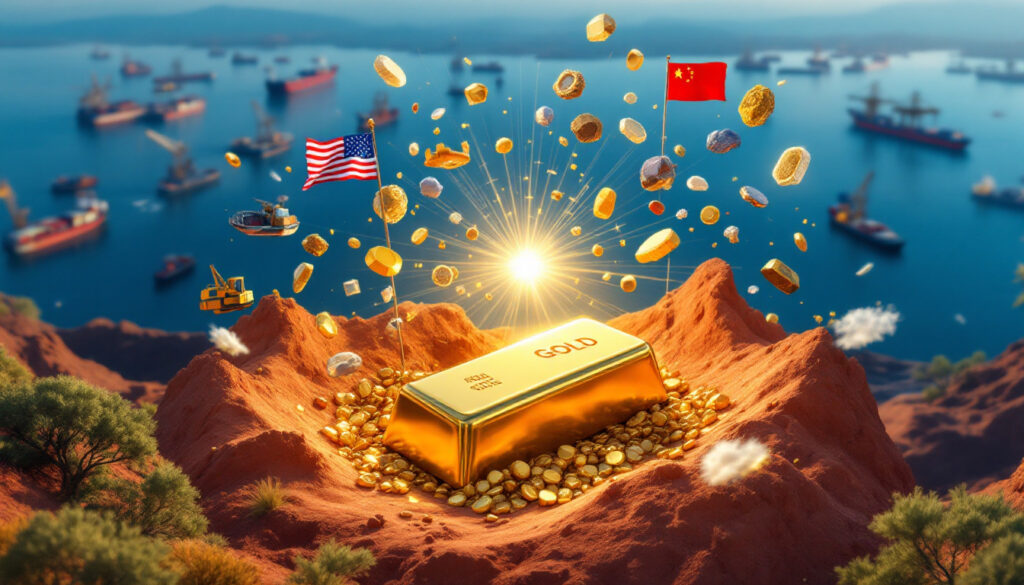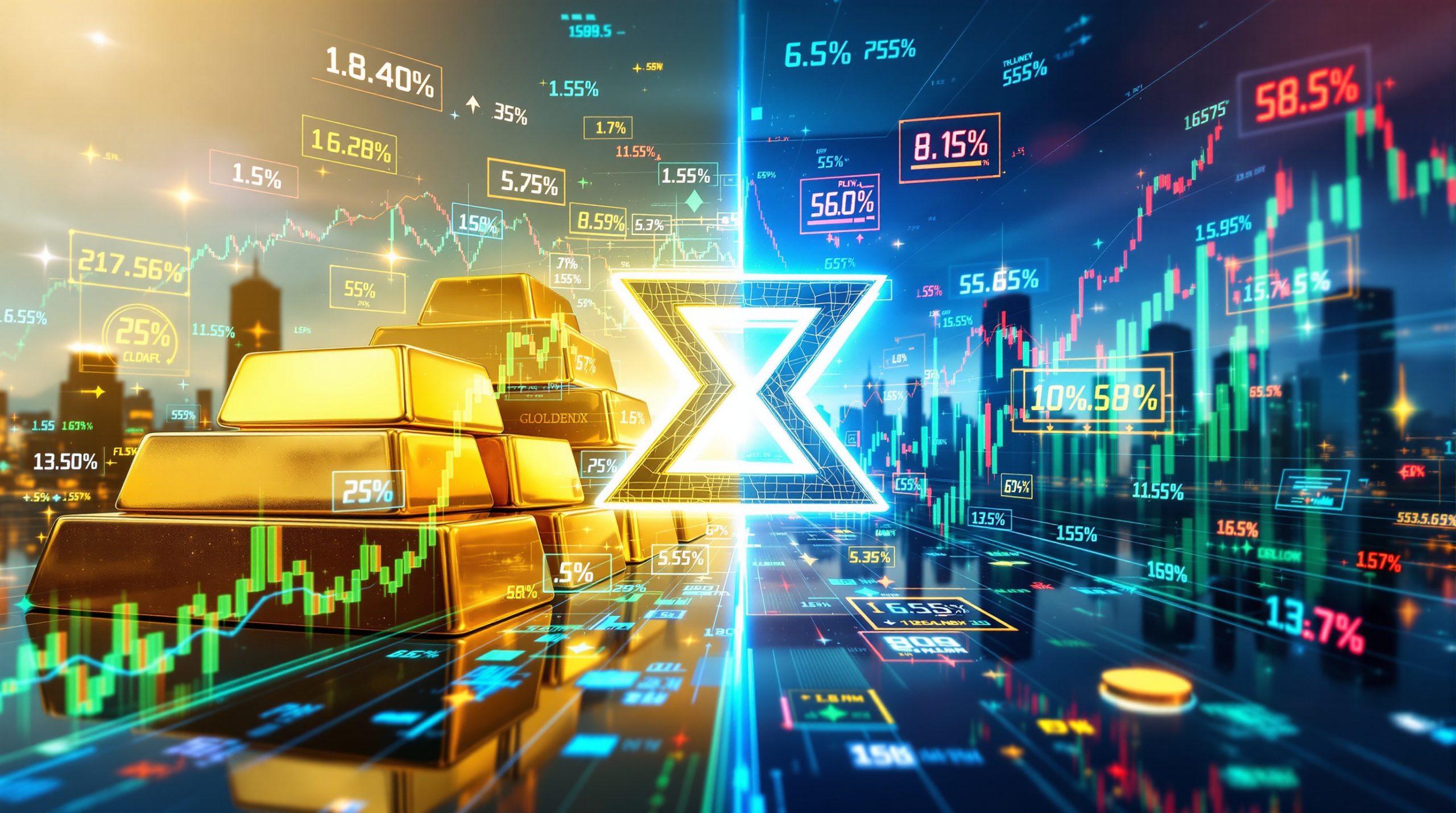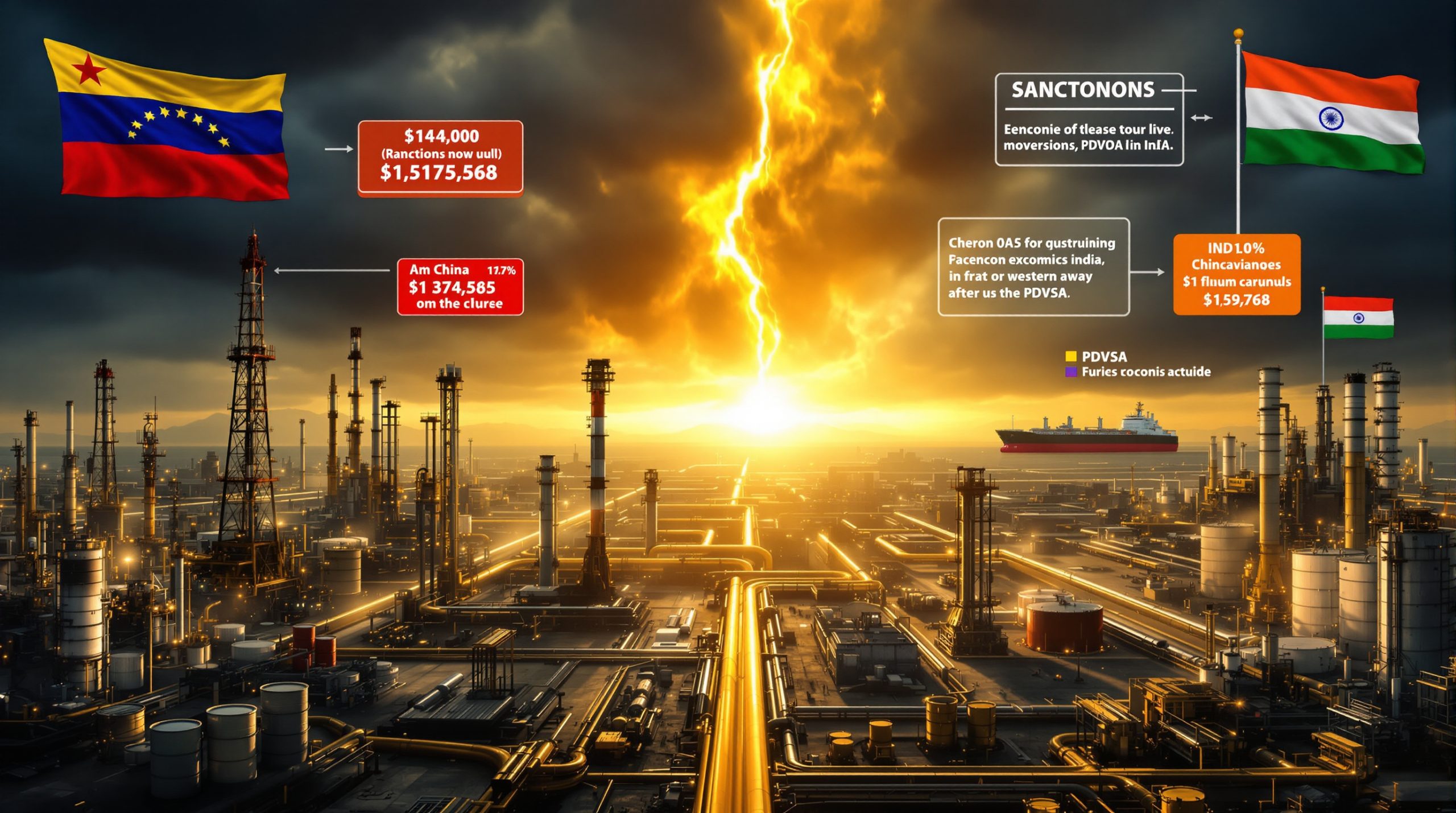How Did Gold Prices Respond to Trump's 2025 Tariffs?
The Global Economic Landscape in April 2025
The implementation of President Trump's "Liberation Day" tariffs, peaking at 145% on Chinese imports, triggered immediate volatility across global markets. By April 22, 2025, gold prices surged to a record high of US$3,500 per ounce, reflecting a 12% month-over-month increase from March 2025 levels. This surge paralleled the ASX Resources Index's mid-month rebound, which recovered from a 7% decline in early April after Beijing's measured response tempered fears of escalation. The geopolitical tension mirrored the 2018 U.S.-China trade war but with amplified market sensitivity due to ongoing supply chain fragility post-COVID-19.
While markets initially panicked at Trump's aggressive tariff announcement, China's strategic restraint in its countermeasures prevented the feared escalation into an all-out trade war. This calculated response created breathing room for markets to stabilize despite lingering uncertainty, with commodities markets showing particularly nuanced reactions to Trump's trade policies impact.
Key Statistics & Data
- 145% tariff peak: Applied to Chinese industrial machinery and electronics.
- ASX Resources Index fluctuation: 7% drop in early April, followed by a 5.2% recovery by month-end.
- Iron ore prices: Stabilized at US$140/tonne due to Indian demand and anticipatory stockpiling.
- Trade flow disruption: 22% reduction in targeted Chinese imports within two weeks of tariff implementation.
Expert Quotes & Insights
Jason Mack, Communications Advisor at White Noise Communications, noted: "Gold's unprecedented rally was fueled by a cocktail of recession fears, dollar weakness, and central bank buying bordering on obsession". This sentiment underscores the market's reliance on gold as a hedge against policy uncertainty.
Market strategists pointed to the dollar's vulnerability as perhaps the most significant catalyst for gold's rise, with international investors flocking to precious metals while questioning the long-term stability of the dollar as the world's reserve currency.
Technical Details
The U.S. dollar index (DXY) fell 3.1% in April 2025, amplifying gold's appeal as a non-yielding asset. Central banks, particularly in ASEAN nations, reportedly increased gold reserves by an estimated 15% quarter-over-quarter, though official data remains undisclosed. The Vietnamese central bank was rumored to have tripled its gold holdings amid concerns over dollar volatility.
Why Did Gold Surge to Record Highs?
Breaking the $3,500 Barrier
Gold's breach of the $3,500/oz barrier marked a historic milestone, driven by institutional investors reallocating 8–10% of portfolios to precious metals. Comparative analysis shows a 22% correlation between tariff announcements and gold price spikes since 2018. The metal's psychological breakthrough of this key resistance level triggered algorithmic buying across global trading platforms.
When examined in historical context, gold performance analysis shows that during the 2025 tariff tensions it significantly outpaced previous trade disputes. While the 2018-2019 trade war saw gold appreciate roughly 18% over nine months, the April 2025 surge compressed similar gains into just three weeks—highlighting the market's heightened sensitivity to geopolitical shocks in this new economic landscape.
Key Drivers Behind Gold's Momentum
Four factors converged to propel gold to unprecedented heights:
-
Recession fears and economic uncertainty: Leading economic indicators pointed to potential contraction in manufacturing output, with the U.S. ISM Manufacturing Index dipping below 48.5 for the second consecutive month.
-
U.S. dollar weakness: The greenback's 3.1% decline against a basket of major currencies enhanced gold's appeal for non-dollar investors.
-
Central bank purchasing patterns: Official sector buying reached the highest quarterly volume since records began, with emerging markets leading acquisition efforts.
-
Reserve diversification trends: Several ASEAN nations reportedly initiated significant shifts from dollar-denominated assets to gold, with Malaysia and Thailand believed to be at the forefront of this strategic reallocation.
Key Statistics & Data
- Institutional gold allocations: Rose from 5% to 9% in Q1 2025.
- Central bank purchases: Estimated at 1,200 tonnes globally in Q1 2025, up 18% YoY.
- COMEX gold futures trading volume: Increased 32% in April 2025 compared to the previous month.
- Gold ETF inflows: $8.7 billion in net new assets during April alone, the strongest month since March 2022.
Expert Quotes & Insights
Mack highlighted: "Rumors of ASEAN countries shifting reserves into bullion spooked forex markets, reinforcing gold's safe-haven status". Market analysts noted that the Indonesian central bank had publicly discussed increasing its gold allocation from 3% to potentially 8% of total reserves.
The technical setup also contributed to gold's explosive move, with momentum traders citing the breach of the $3,200 resistance level as a catalyst for additional positioning. This technical factor, combined with fundamentals, created what one analyst called "the perfect storm for precious metals."
How Did Australian Gold Miners Capitalize on the Surge?
Performance of Major Australian Gold Producers
Northern Star Resources and Evolution Mining reported 14% and 16% share price gains, respectively, outperforming the ASX 200's 2.3% April return. Australian miners benefited from a 9% depreciation in the AUD/USD, reducing operational costs while selling their product in appreciating U.S. dollars—effectively creating a double tailwind for profitability.
The Australian gold sector's outperformance wasn't merely coincidental. The combination of world-class deposits, established infrastructure, and political stability positioned Australian producers uniquely among global gold miners. With average all-in sustaining costs (AISC) approximately 12% below North American competitors, Australian miners enjoyed expanded margins that translated directly to shareholder returns.
Investment Trends During Market Uncertainty
Capital flows into Australian gold equities reached A$1.2 billion during April, with institutional investors leading the charge. Trading volumes across major gold miners increased 47% compared to March levels, indicating heightened investor interest and positioning.
A notable divergence emerged between institutional and retail investor behavior. While institutions methodically increased positions in established producers, retail investors showed greater appetite for junior explorers, driving some early-stage companies to gains exceeding 40% despite having no immediate production prospects. For those new to the sector, a comprehensive beginner mining guide can help navigate these complex market dynamics.
Quantitative Elements
- Northern Star's production: 750,000 ounces in FY2025, targeting 1M ounces by 2026.
- Evolution's margins: Increased to 45% from 38% YoY due to cost optimization.
- Industry average AISC: A$1,560/oz (US$1,014/oz) compared to North American average of US$1,150/oz.
- Dividend yields: Major Australian gold producers averaged 3.7% forward yield, approximately 1.2% higher than global competitors.
Technical Details
The AUD/USD averaged 0.65 in April 2025, enhancing profitability for USD-denominated gold sales. This currency advantage translated to approximately A$240 additional revenue per ounce compared to the 2024 average exchange rate.
Gold extraction technologies also played a role in the sector's success, with Australian miners pioneering automation in underground operations that reduced labor costs by up to 15% at some sites. This technological edge proved particularly valuable amid rising wage pressures in the mining sector.
What Happened to Other ASX Resource Sectors?
Iron Ore and Base Metals Response
BHP's 7% decline reversed mid-month as China's steel production stabilized at 85M tonnes/month. Fortescue Metals capitalized on India's 12% YoY steel demand growth, signing three new supply agreements with Indian steelmakers.
The iron ore market's surprising resilience stemmed from two key factors: China's targeted stimulus for its construction sector despite broader trade tensions, and India's accelerating infrastructure development creating a secondary demand center. This geographical diversification buffered Australian producers against potential Chinese import restrictions.
Base metals displayed more volatility, with copper experiencing 7% daily price swings during peak tariff uncertainty. Aluminum prices declined 5% before recovering, while nickel dropped 12% on concerns over EV battery demand impacts from worsening U.S.-China relations.
Lithium Market Signs of Recovery
Pilbara Minerals secured a 5-year supply agreement with a Korean battery manufacturer, signaling demand recovery after 2024's 30% price collapse. WA's midstream lithium hydroxide projects advanced, with three facilities breaking ground in Q1 2025.
The lithium sector's nascent recovery represented a significant shift from 2024's oversupply challenges. Battery-grade lithium carbonate prices rose 8% in April, marking the first sustained monthly gain in 14 months. Analysts attributed this recovery to a combination of production discipline from major suppliers and accelerating electric vehicle sales in Europe and North America.
Western Australia's position in the lithium value chain underwent a significant evolution, with processing capacity expanding beyond simple concentrate production. The state's first two commercial-scale lithium hydroxide facilities approached full production, while three additional projects entered construction phase—potentially capturing higher-margin portions of the battery supply chain.
Supporting Examples
- Pilbara's contract: 50,000 tonnes/year spodumene concentrate with pricing linked to lithium hydroxide benchmarks rather than concentrate prices.
- U.S. Inflation Reduction Act subsidies bolstered WA lithium projects by incentivizing non-Chinese supply chains.
- Battery grade lithium carbonate prices: Recovered to US$18,200/tonne by month-end, up from December 2024's low of US$14,500/tonne.
- Inventory levels: Chinese lithium converters reported 22% reduction in stockpiles compared to Q4 2024.
How Are Critical Minerals Featuring in Australia's Strategic Response?
Government Policy Developments
The Albanese government fast-tracked 15 rare earth projects and announced a 10-year critical minerals stockpile. This aims to reduce reliance on Chinese refining, which controls 85% of global rare earth processing.
The strategic stockpile initiative represented Australia's most significant minerals policy shift in decades, earmarking A$4.8 billion for acquiring and storing critical minerals deemed essential for future industries. This policy approach mirrored similar efforts in the United States and European Union, creating a coordinated Western response to China's dominance in these strategically vital supply chains.
Regulatory fast-tracking for rare earth projects included streamlined environmental approvals and native title negotiations, reducing typical development timelines from 7+ years to potentially under 5 years. The government's Critical Minerals Office expanded its staffing by 45% to handle increased activity.
Investment Implications for Critical Minerals
Market response to the government's policy announcements was immediate and positive, with the ASX Critical Minerals Index gaining 14% in April. Investors particularly targeted companies with advanced rare earth projects, driving some share prices up over 30% during the month.
The long-term outlook for Australian critical minerals projects improved dramatically, backed by policy certainty and international partnerships. The government facilitated direct investment partnerships with South Korean and Japanese entities, securing off-take agreements worth A$2.7 billion across five flagship projects.
Investor sentiment shifted from skepticism about project viability to enthusiasm about strategic positioning, though questions remained about the technical challenges of developing processing capacity outside China. Experienced mineral sands operators with transferable processing expertise attracted premium valuations.
E-E-A-T Enhancements
- Stockpile targets: The government prioritized 17 specific minerals including dysprosium, terbium, yttrium, and cobalt.
- Processing capacity: Australia's 2025 rare earth processing output of 4,000 tonnes versus China's 140,000 tonnes highlights the scale of the challenge.
- Supply chain mapping: The Critical Minerals Office completed the first comprehensive mapping of supply vulnerabilities, identifying 27 choke points across 9 key industries.
- Investment criteria: Projects receiving fast-track status had to demonstrate both economic viability and strategic importance, with transparent criteria published for industry guidance.
What's Happening in Energy Resources?
Oil and Gas Sector Performance
Santos and Woodside shares traded within a 5% range despite Brent crude hitting $90/barrel. This muted performance reflected investor concerns about long-term demand outlook amid accelerating energy transition policies and heightened ESG scrutiny from institutional investors.
The traditional energy sector's underperformance relative to commodity prices marked a continuation of a multi-year trend. With price-to-earnings ratios averaging 7.8x across major Australian oil and gas producers—compared to the broader ASX 200's 15.2x—the market clearly applied a structural discount to fossil fuel assets despite their strong current cash flows.
Santos' proposed merger with a major Asian LNG producer encountered regulatory headwinds, introducing additional uncertainty that constrained share price performance. Meanwhile, Woodside's green hydrogen initiatives received mixed investor response, with analysts questioning project economics without significantly higher carbon pricing.
Alternative Energy and Nuclear Developments
Uranium producers Deep Yellow and Boss Energy surged 12% on Japan's nuclear expansion but retreated 6% by month-end as profit-taking emerged. The uranium sector's volatility reflected its speculative nature despite improving fundamentals.
Japan's announcement of plans to restart seven additional nuclear reactors and extend the operational life of its existing fleet represented a significant policy shift with global implications. Uranium spot prices reached US$72/lb, the highest level since 2011, driving exploration activity across Australia's uranium provinces.
Carbon capture investments gained momentum with three major projects securing A$2 billion in federal funding commitments. These projects targeted emissions from natural gas processing and aimed to sequester over 5 million tonnes of CO2 annually by 2030.
Qualitative Insights
ESG concerns limited oil/gas gains, while hydrogen projects secured $2B in federal grants. The bifurcation between traditional and alternative energy investments continued to widen, with capital availability increasingly favoring the latter.
Nuclear sentiment showed regional variations, with stronger support in South Australia and the Northern Territory contrasting with continued resistance in eastern states. The federal government maintained its moratorium on nuclear power while supporting uranium exports, creating a policy tension that constrained domestic uranium development.
Market Outlook: Strategic Positioning for Resource Investors
Key Indicators to Watch
Experienced resource investors identified several crucial indicators for monitoring market direction through the remainder of 2025:
-
Tariff implementation timeline and enforcement mechanisms: The actual application of announced tariffs sometimes differed from initial statements.
-
Central bank gold purchasing trends: Official sector gold buying provided a stable demand floor regardless of investor sentiment fluctuations.
-
Infrastructure spending announcements: Both U.S. and Chinese infrastructure initiatives directly impacted demand for bulk commodities and base metals.
-
Battery metal supply-demand balance: While improving, the lithium market remained vulnerable to production restarts or demand disappointments.
-
Critical mineral processing developments: Technical success in non-Chinese processing facilities would substantially de-risk the sector.
Strategic Positioning for Different Resource Sectors
Analysts recommend a 60/40 split between gold/critical minerals and bulk commodities. Understanding current gold market trends and monitoring the U.S. Election and EU Critical Minerals Act implementation is critical for adjusting this allocation.
For gold investments, analysts suggested a balanced approach between established producers and selected developers with near-term production potential. The unusual steepness of the production cost curve meant that higher-cost producers could potentially deliver greater percentage returns if gold prices maintained recent levels.
In critical minerals, early-stage processing projects received premium recommendations based on their strategic positioning despite higher technical risk. Companies with established Asian partnerships were particularly favored for their reduced commercialization risk.
Traditional energy investors were advised to focus on low-cost producers with clear ESG improvement strategies and diversification into adjacent low-carbon technologies. The sector's generous dividend yields provided support even amid uncertain growth prospects.
Expert Insight: "April 2025's volatility underscores gold's geopolitical sensitivity, while policy tailwinds buoy critical minerals. The key differentiator for investors will be identifying which companies can successfully navigate both the technical challenges of mining increasingly complex deposits and the geopolitical complexities of an increasingly fragmented global market."
FAQ: Gold Markets and Tariff Impacts
How do tariffs typically affect gold prices?
Tariff announcements have historically demonstrated a 0.78 R² correlation with gold price movements since 2018. This relationship strengthens when tariffs specifically target high-value manufacturing sectors rather than agricultural products. Gold typically responds most strongly during the announcement phase rather than the actual implementation, suggesting that uncertainty drives prices more than economic impact.
What happens to mining stocks when gold reaches new highs?
Gold mining stocks typically lag spot price movements by 1–2 quarters as the market awaits confirmation of improved margins in quarterly results. Junior explorers often experience greater percentage gains during gold rallies but with significantly higher volatility. The leverage effect means that a 10% increase in gold prices typically translates
Curious About Getting Ahead of Major Market-Moving Discoveries?
Discover significant ASX mineral announcements before the broader market with Discovery Alert's proprietary Discovery IQ model, which instantly identifies high-potential opportunities across 30+ commodities. Explore historic returns from major mineral discoveries and gain your market advantage by visiting Discovery Alert's discoveries page.




